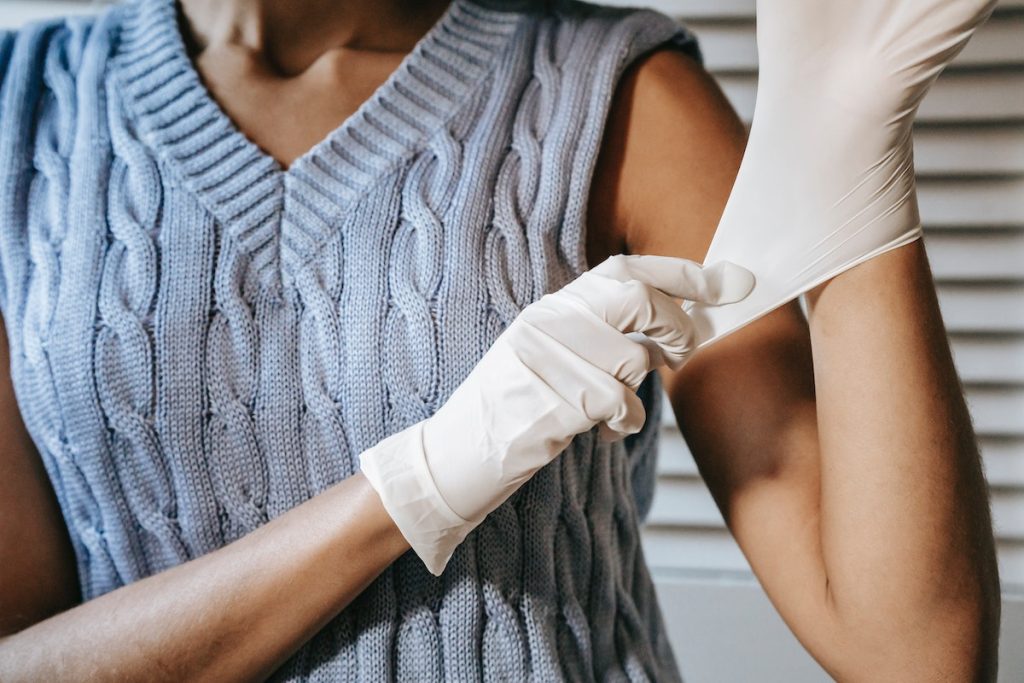- Finger gloves are latex, vinyl, or rubber finger protectors that can be made at home or bought from a store.
- Finger gloves are also called finger cots, sleeves, or stalls.
- Finger cots are used in many professions, such as medical or lab work, industrial work, beauty and personal care, pet care, gaming, and jewelry cleaning.
- You can easily make a finger cot by cutting a part of a latex glove, adding it to your finger, and securing it with electrical tape.
Did you know that there are about 340 million work-related accidents per year? The majority include at least some kind of bruise or cut that could lead to a more significant issue if not taken care of.
This is why so many workers are required to wear hand covers as added protection to prevent injury. But how can they avoid those wildly uncomfortable and limiting hand covers? That is easy – they can go with finger gloves!
In this article, we will talk about what finger covers are, and how you can make them at home in just a few simple steps. If you want to learn more, stick around.

What are Finger Gloves?
Finger gloves are the types of gloves people use when they need to cover only the fingers. You might be able to find finger gloves for two fingers at the same time, but they are not that common.
Many people mistake finger gloves for gloves with an open-finger design, but these two do not refer to the same thing. The open-finger gloves are called fingerless gloves, and they cover the palm and half the finger without covering the tips.
Other terms used for finger gloves include “finger cots,” “finger sleeves,” or “finger stalls.” They all have similar uses and designs, so whichever you choose will depend on your needs and preferences.
What are Finger Gloves Used For?
Finger gloves are used for many things, but the most common use is for protecting bruised or cracked fingertips. If you have ever had a cut on your fingertip, you must know how uncomfortable it is to keep bumping it into things and reopening the wound. A finger cot can save you from a world of pain as it will cover and seal the cut, keeping it protected at all times.
But this is not the only use for these gloves. In fact, people from all professions wear them – doctors, tech guys, beauticians, veterinarians, gamers, and many others. Let’s look into each of these professions to see where finger gloves are applicable.
Medical Work
Doctors are probably the people who use finger gloves the most. In recent years, they have started replacing the full latex gloves with these finger gloves because they are way more convenient and comfortable. They allow you to freely move your fingers while working, which offers way more precision than with latex gloves.
A doctor who needs to apply some topical cream on a patient could use a finger glove to avoid getting their skin in contact with the cream and prevent any infections. They could also use the finger glove when doing rectal or vaginal exams as protection against sexually-transmitted infections that can be transmitted by touch, such as herpes or syphilis.

Lab Work
In addition to doctors, laboratory scientists can also use finger gloves when examining some biological specimens. Half-finger gloves are a good replacement for standard latex gloves in this case, but both doctors and lab scientists must dispose of the gloves after using them.
Electronic Engineering
Electronic engineers could also put the half-finger gloves to good use when working with devices that have sensitive components. Handling small and sensitive components is much easier with finger gloves and it improves the user’s grip. Also, they will avoid getting their sweat and dust all over the device.
Industrial Tasks
Industrial workers can also use disposable gloves instead of fabric gloves if they want to be more precise and keep things clean. Finger gloves will come in handy when they need to touch oil or grease or when they need to put their finger into a narrow or dirty area. That way, their skin will stay protected throughout the course of their work.
Beauty and Personal Care
Beauticians deal with many chemicals or harmful substances they do not want to touch their skin. For example, hair care professionals have to use bleach or hair dye infused with harsh chemicals. Instead of handling the chemicals with their bare fingers, they can use finger covers to stay protected while still being precise.
The same goes for wax technicians who have to touch the skin of multiple people daily. In some cases, waxing can also lead to bleeding, so the estheticians must have finger or hand covers to avoid directly touching the blood.

Pet Care
Veterinarians and pet groomers use finger covers when dealing with our furry little friends. Veterinarians need finger cots when performing exams or surgeries on pets, whereas pet groomers need them when handling grooming tools. Animals deserve good quality service and proper sanitation too!
Jewelry Care
Jewelry cleaning requires people to use finger covers to stay precise. If you need to grease up one piece and are not careful, the grease will make its way to the surrounding elements. That might cause those elements damage.
If you are wearing a finger cover, you can put just a bit of grease on it and move the finger to the part that needs to be greased. As mentioned before, this will be much more convenient than wearing a full glove that does not allow your fingers to move precisely.
Gaming
Believe it or not, there are special finger cots that look much like sleeves and are used for more convenient gaming. These stretchy sleeves can help gamers by absorbing their sweat and reducing friction between their fingers and the mobile device screen.
How to Make Finger Gloves?
It’s always a struggle to figure out what to pack for trips, and it’s easy to forget important things like finger gloves. No worries – you can make some yourself. The entire process will only last a few minutes and require a few tools you might have lying around. Here is how you can make finger gloves at home:
Step 1 – Gather All Necessary Tools
Before you start, you need to gather a few necessary things – a clean glove that has not been used before, a pair of scissors, and some electrical tape.
There are several types of disposable gloves – latex, vinyl, polyethylene, and rubber. You can use whichever you like, but remember that latex and rubber finger protectors are the most comfortable and flexible. You can even go with natural rubber or natural latex if you have sensitive skin and want to avoid developing a rash.
Step 2 – Cut the Glove
Most gloves are a one-size-fits-all type of gloves, but just to be on the safe side, you should try them on to see if they fit well. Then, look at your finger and think about the preferred length of your finger cots. When you decide on your preferred length, cut the fingers of the glove. You can also cut a 3-inch long piece of tape that you will use later on.
Step 3 – Prepare Your Fingers for the Finger Glove
Before putting your finger cot on, you must ensure that your injured finger has been washed and disinfected. If you want to, you can also lubricate the finger before putting on the cot, as this will create less friction between the finger and the cot.
Step 4 – Put on the Finger Glove
Now, put the cot or glove on your finger and stretch it down. When you have it in the correct position, wrap the tape around the base of your finger so that it holds the cot in place. It should be half on the cot and half on your skin.
Ensure you do not wrap your finger too tight, as that will lead to reduced blood flow to the finger and even more trouble. It should be just tight enough.
Finger Gloves – Make Your Own and Try Them
Finger gloves are an excellent alternative to latex gloves as they offer protection, yet still allow you to be precise with your work. Not only that but they are super easy and affordable to make yourself. In this article, we went over the steps and materials needed to DIY finger gloves, so hopefully you’ll have no trouble making them. Regardless of your line of work, next time you need finger gloves, make your own and try them out. Once you do, you’ll never go back to standard gloves again.











